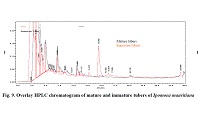Chromatographic estimation of maturity based phytochemical profiling of Ipomoea mauritiana
Keywords:
Microscopy, HPLC, HPTLC, proximate analysis, phytochemical screeningAbstract
Collection of herbs at right maturity is one of such parameter which affect afficacy of medicinal plants. Standard reference markers used in quality control of herbal drugs mostly authenticate identity and not efficacy. In order to derive bioactive markers, knowledge regarding appropriate collection time for each herb is essential. Traditional medical knowledge is bioactivityoriented and informs about best time of collection for certain medicinal species, as observed in case of Ipomoea mauritiana Jacq. (Vidari–Sanskrit). Only mature (bigger size) tubers of Ipomoea mauritiana are used by Traditional Medical Practitioners (TMP) for preparing galactagogues and immunomodulatory herbal medicines (Rasayan). Microscopy of transverse sections revealed structural variation between mature and immature tubers and girth of tubers determine the maturity of plant, the difference in phytochemical profiles of mature and immature tubers was observed. Variation in phytoconstituents of mature and immature tubers was confirmed through proximate analysis, phytochemical screening, qualitative HPLC and HPTLC analysis revealed the variation in phytoconstituents in mature and immature tubers.
References
Schepetkin AI, Quinn MT. Botanical
polysaccharides Macrophage Immunomodulation
and therapeutic potential. Inter. J.
Immunopharmacol. 2006, 6:317-33.
Prats A, Harborne JB. New sources of Ergoline
Alkaloids within the Genus Ipomoea. Biochem.
Sys. Eco. 1993, 214:455-62.
Ferreira AA, Amaral FA, Duarte IDG, Oliveira
PM, Alves RB, Silveira D, Azevedo AO, Raslan
DS, Castro MSA. Antinoceptive effect from
Ipomoea Cairica extract. J. Ethnopharmacol
, 105(1-2): 148-53.
Mungantiwar AA. Studies on the
immunomodulatory effects of Boerhavia diffusa
alkaloidal fraction. J. Ethnopharmacol 1994,
:125-31.
Anonymous. Quality control methods for
medicinal plant materials 1998, WHO, Geneva.
Anonymous. Official methods of analysis
Association of Official Analytical
Chemists, 11th ed. Washington D.C.154.
Dawidar AM, Winternitz F, Johans SR.
Structure of Ipomine, a new alkaloid from
Ipomoea muricata Jacq. Tetrahedron 1999,
:1733-34.
Locher CP, Burch MT, Mower HF,
Berestecky I, Davis H, Van B, Lasure A,
Vanden DA, Vlietinck AJ. Anti-microbial
activity and Anti-complement activity of
extracts obtained from selected hawaiian
medicinal plants. J. Ethnopharmacol. 1995,
:23-32.
Dharmaratne HR, Weerawardhena ULBJ,
Herath HMTB, Fujimoto Y. Chemical
investigation of the Methanol extract of root
tubers of Ipomoea mauritiana Chem. Res.
Commun. 1997, 6:39-41.
Zhao G, Kan J, Li Z, Chen Z.
Characterization and Immunostimulatory
activity of an (1-6)-alpa-D-glucan from root
of Ipomoea batatas. Int. J. Immuno. 2005,
:1436-45
Hueza IM, Fonseca ESM, Paulino CA,
Haraguchi M, Gorniak SL. Evaluation of
immunomodulatory activity of Ipomoea
carnea on peritoneal cells of rats J.
Ethanopharmacol. 2003, 87:181-86.
Douglas JA, Smallfield BM, Burgess EJ,
Perry NB, Anderson RE, Malcolm H,
Douglas IAGV. Sesquiterpene lactones in
Arnica montana: A rapid analystical method
and the effects of flower maturity and
stimulated mechanical harvesting on quality
and yield. Planta Med. 2004, 70:166-170.
Narayana K, Iyer MA, Kolammal M:
Pharmacognosy of Ayurvedic Drugs Kerala.
, 1:37-41.
Lamidi M, Rondi ML, Ollivier E, Faure R,
Nzeekekang L, Balansard G. Constituents of
Ipomoea fistulosa leaves Fitoter. 2000,
:203-04.
Davis L, Kuttan G. Immunomodulatory activity of
Withania somnifera. J. Ethnopharmacol. 2000,
:193-200.
Van L, Bodil E, Lindberg F, Lindberg T. Effect of
Harvesting interval and defoliation on yield and
chemical compostion of leaves, stems and tubers
of Ipomoea batatas plant parts. Agric. Sci. 2003,
:211-20.
Bieber LW, Filho AADS, Lima RMOC,
Chiappeta ADA, Nascimento SCD, Souza IAD,
Mello JFD, Veith HJ. Anticancer and
antimicrobial glycosides from Ipomoea bahiensis.
Phytochem. 1996, 25:1077-81.
Souza MD. Antinociceptive properties of the
methanolic extract obtained from Ipomoea Pescaprae (L) R. J. Ethanopharmacol. 2000, 69:85-
Schoeninger MJ, Bunn HT, Marray SS, Mariett
JA. Compostion of tubers used by Hadza foragers
of Tanzania. J. Food Comp. Anal. 2001, 14:15-20.
Saho N. Acylated Petargonidin Glycosides in
Red-purple flowers of Ipomoea purpurea.
Phytochem. 1996, 436:1365-70.
Mann P, Tofern B, Tofern MK, Eich E. Flavonoid
Sulfates from the Convolvulaceae. Phytochem.
, 50:267-71.
Chopra RN, Nayer SL, Chopra IC. Glossary of
Indian medicinal plants, First edition, 3rd reprint,
NISCAIR. 1992, 142.
Srivastava R, Sachdeva K, Madhusudanan KP,
Dinesh K. Kulshveshtha structure of Pescaproside
E. a fatty acid glycoside from Ipomoea
Pescaprae. Carbo. Res. 1991, 212:169-76.
Cambie RC, Fergusion LR: Potential functional
Foods in the traditional Maori Diet. Mut. Res.
, 109-17.
Miranda RP, Cartos BH. HPLC isolation
and structural elucidation of diasteromeric
niloyl ester tetrasaccharides from Mexican
Scammony root Tetrahedron 2002, 58:3145-
Gonda R, Tomoda M, Shimiza N. Strucrure
and Anticomplementary activity of an acidic
polysaccharide from the leaves of Malva
sylvestris var. mauritiana. Carbo. Res. 1990,
:323-29.
Mishra SS, Tiwari JP, Matin A.
Investigation of fixed oil from Ipomoea
digitata tubers. J. Pharma. Sci. 1965,
:471-2.
Schimming T, Jenett-Siems K, Mann P,
Tofern-Reblin B, Milson J, Johnson RW,
Deroin T, Austin DF, Eich E. Calystegines
as chemotaxonomic markers in the
Convolvulaceae. Phytochem. 2005, 66:469-
Chen TE, Huang DJ, Lin YH. Isolation and
characterization of Serine protease from the
storage roots of Sweet potato. Plant Science.
, 166:1019-26.
Tiwari U, Rastogi B, Singh P, Saraf DK, Vyas
SP. Immunomodulatory effects of aqueous
extract of Tridax procumbens in experimental
animals. J. ethnopharmacol. 2004, 92:113-9.
Singh V, Pandey M, Srivastava A, Sethi R. A
non-ionic water soluble seed from Ipomoea
campanculata. Fitoter. 2003, 74:40-41.
Woradulayapinij W, Soonthornchareonnon N,
Wiwat C: In Vitro HIV type 1 reverse
transcriptase inhibitory activities of Thai
medicinal plants and Canna indica L. rhizomes. J.
ethnopharmacol. 2005, 101:84-9.
Lothar WB, Filho AADS, Lima RMOC,
Chiappeta ADA, Nascimento SCD, Souza
IAD, Mello JFD, Veith HJ. Anticancer and
Antimicrobial Glycosides from Ipomoea
bahiensis. Phytochem. 1996, 25:1077-81.
Miyazaki Y, Kusano S, Doi H, Aki O. Effects on
immune response of Anti diabetic ingredients
from white skinned Sweet potato. Nutri. 2005,
:358-62.



